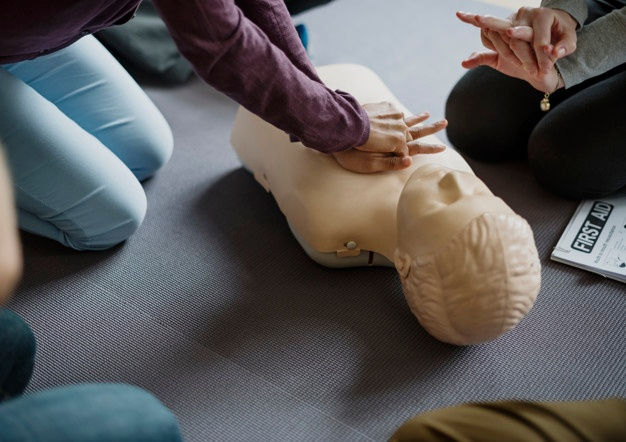CPR Classes | Quick Action From Bystanders Saves a Life in Pennsylvania
- oliver591
- Apr 19, 2022
- 2 min read

For Stacey Sassaman and Lloyd Emelle, it was a day like any other. They were visiting Stacey’s brother in Westchester, PA and decided to spend a quiet afternoon at the neighborhood coffee shop.
The two took up seats next to an elderly man who seemed to be sitting and quietly daydreaming to himself. After a while the man, Joe, fell asleep in his armchair. Stacey, a medical student, noticed his sleep seemed erratic and his breathing uneven, so she and Lloyd opted to keep an eye on him.
Almost an hour later, Joe’s breathing appeared to be getting heavier and he was struggling. “At this time we were increasingly concerned about his symptoms,” explains Lloyd, a former lifeguard.
“Stacey went to alert the baristas that he might need help, and I began to mentally prepare myself for the possibility that I may need to perform CPR. That’s when I saw him stop breathing.”
Lloyd and Stacey immediately jumped into action. Lloyd cleared the surrounding furniture as Stacey checked for a pulse. Right as she found it, it disappeared. They moved Joe to the floor, and Stacey began to perform Hands-Only CPR. The barista Stacey had spoken to called 9-1-1.
Stacey and Lloyd performed Hands-Only CPR for almost 4 minutes until the paramedics arrived and took over. Once his pulse was restored, Joe was transported to a local hospital where he recovered.
“Speaking of the experience now seems surreal,” shares Lloyd. “I’m an Eagle Scout. It’s my mindset to be ready for anything, though I never expected something like this. I learned CPR growing up in Houston. My mom enrolled me in a city program for disadvantaged kids where I learned how to swim and eventually trained to be a lifeguard.”
“Not everyone needs to be an EMT, doctor, etc.,” added Stacey, who is studying to be an OBGYN. “But everyone should know the basics. One of the most alarming parts of this experience was, when Joe stopped breathing, everyone else in the cafe froze. I asked the barista if they had an AED, but he didn’t know how to respond. If Lloyd and I hadn’t been there, it’s likely no one would have been able to help.”
This is why Stacey, who is trained in BLS and ACLS, so strongly recommends the American Heart Association training—not just for medical professionals but for everyone.
“My training through the Association was great,” concludes Stacey. “What made it so effective is that it wasn’t just a lecture, but rather a hands-on experience. You don’t want to have to stop and think when seconds really count. I have no doubt that my training was critical to saving that man’s life.”
Learn, Enjoy and Save Life. HealthForce Training Center offer services such as Basic Life Support (BLS), Advance Cardiovascular Life Support (ACLS), Pediatric Advance Life Support (PALS), CPR AED, Pediatric First Aid CPR AED and First Aid CPR AED. Read more of our blogs.
Source(s):





AV在线看 AV在线看;
自拍流出 自拍流出;
国产视频 国产视频;
日本无码 日本无码;
动漫肉番 动漫肉番;
吃瓜专区 吃瓜专区;
SM调教 SM调教;
ASMR ASMR;
国产探花 国产探花;
强奸乱伦 强奸乱伦;
AV在线看 AV在线看;
自拍流出 自拍流出;
国产视频 国产视频;
日本无码 日本无码;
动漫肉番 动漫肉番;
吃瓜专区 吃瓜专区;
SM调教 SM调教;
ASMR ASMR;
国产探花 国产探花;
强奸乱伦 强奸乱伦;
代发外链 提权重点击找我;
蜘蛛池 蜘蛛池;
谷歌马甲包/ 谷歌马甲包;
谷歌霸屏 谷歌霸屏;
谷歌霸屏 谷歌霸屏
蜘蛛池 蜘蛛池
谷歌快排 谷歌快排
Google外链 Google外链
谷歌留痕 谷歌留痕
Gái Gọi…
Gái Gọi…
Dịch Vụ…
谷歌霸屏 谷歌霸屏
负面删除 负面删除
币圈推广 币圈推广
Google权重提升 Google权重提升
Google外链 Google外链
google留痕 google留痕
代发外链 提权重点击找我;
游戏推广 游戏推广;
Fortune Tiger Fortune Tiger;
Fortune Tiger Slots Fortune…
谷歌马甲包/ 谷歌马甲包;
谷歌霸屏 谷歌霸屏;
מכונות ETPU מכונות ETPU;
;ماكينات اي تي بي…
آلات إي بي بي…
ETPU maşınları ETPU maşınları;
ETPUマシン ETPUマシン;
ETPU 기계 ETPU 기계;
google seo google seo技术飞机TG-cheng716051;
03topgame 03topgame
gamesimes gamesimes;
Fortune Tiger Fortune Tiger;
Fortune Tiger Slots Fortune Tiger…
Fortune Tiger Fortune Tiger;
EPS машины EPS машины;
Fortune Tiger Fortune Tiger;
EPS Machine EPS Cutting Machine;
EPS Machine EPS and EPP…
EPP Machine EPP Shape Moulding…
EPS Machine EPS and EPP…
EPTU Machine ETPU Moulding Machine
EPS Machine EPS Cutting Machine;